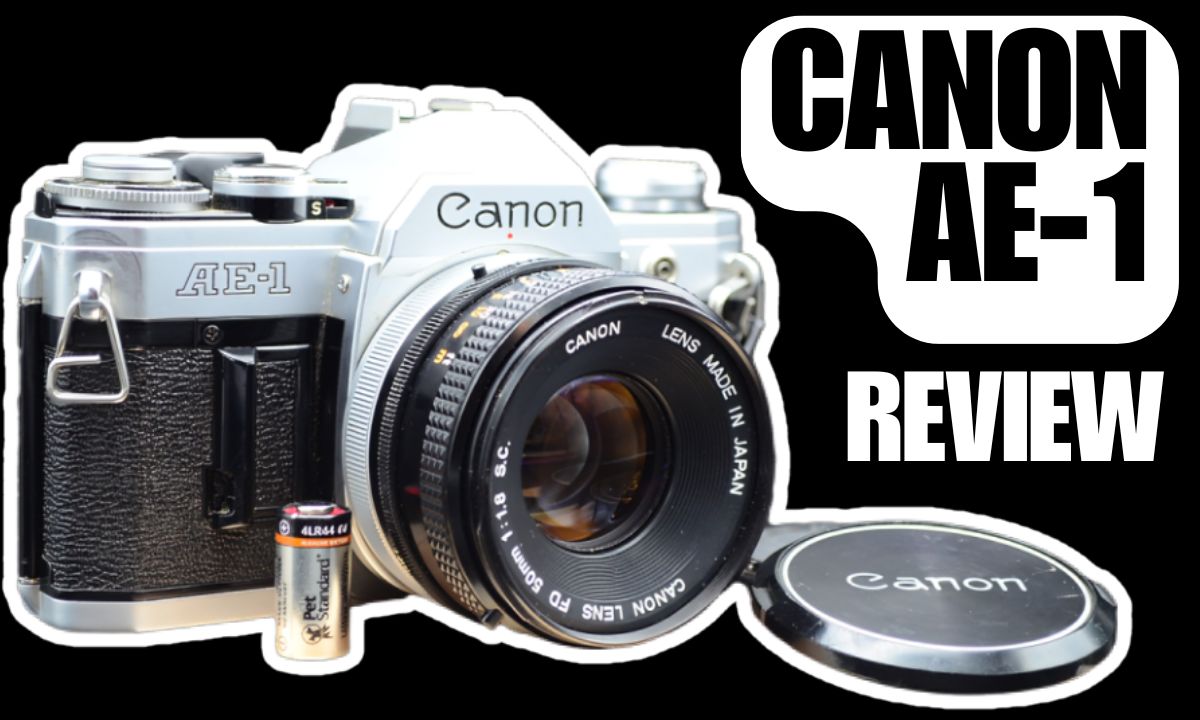The Canon AE-1 isn’t just a camera – it’s a revolution that changed photography forever. When it burst onto the scene in 1976, it brought something entirely new: sophisticated electronics at a price anyone could afford. With its sleek black body, intuitive controls, and groundbreaking microprocessor, the AE-1 turned the photography world upside down.
It wasn’t just about taking pictures anymore; it was about making advanced photography accessible to everyone. This review dives deep into the monster that devoured the camera market, selling over 5.7 million units and cementing Canon’s place in photography history. Let’s explore why this legendary camera still captures hearts today.
Going back…
The mid-1970s photography scene was dominated by mechanical cameras, with brands like Nikon and Pentax leading the charge. Canon, though respected, wasn’t the powerhouse we know today. Everything changed when they took a massive gamble that would revolutionize the industry forever.
Market leaders back then:
- Nikon F2
- Pentax K1000
- Olympus OM-1
The landscape of photography in the early 1970s was vastly different from today’s digital realm. Professional photographers dominated the market, wielding their mechanical marvels with practiced precision. The average consumer found themselves intimidated by the complexity and cost of serious photography. Camera manufacturers focused primarily on professional features, leaving a significant gap in the market for accessible, consumer-friendly cameras.
Enter the AE-1 – Monster Sales
In 1976, Canon unleashed what would become their most successful camera ever. The AE-1 wasn’t just another SLR – it was the first microprocessor-controlled camera aimed at the mass market. This electronic brain changed everything, making advanced photography accessible to everyone.
Key Features That Made It Special:
- Electronic shutter control
- LED viewfinder display
- TTL metering
- Affordable price point ($299 at launch)
What truly set the AE-1 apart wasn’t just its technical innovations – it was Canon’s understanding of the untapped amateur market. By combining advanced features with user-friendly operation, they created a camera that bridged the gap between professional and consumer photography. The AE-1’s electronic brain handled complex exposure calculations automatically, freeing photographers to focus on composition and creativity.
Monster sized marketing
Canon broke all the rules with their marketing campaign. They hired tennis star John Newcombe and launched the famous “Sure Shot” advertisements. This was unprecedented – cameras were traditionally marketed to professionals through technical specs, not to everyday consumers through lifestyle advertising.
The campaign’s success wasn’t just about star power – it was about changing the conversation around photography. Instead of technical jargon, Canon spoke about memories, moments, and the joy of capturing life. They showed people using cameras in everyday situations: at parks, family gatherings, and sporting events. This approach democratized photography, making it accessible to everyone.
“The camera that turns advanced photography into child’s play” – Original Canon marketing slogan
Monster cut backs on quality
To hit their aggressive price point, Canon made some compromises. The top plate was plastic chrome instead of brass, and early models developed the infamous “Canon squeal” – a high-pitched whine from the electronic components.
Common Issues Table:
| Problem | Frequency | Severity |
| Squealing noise | Very common | Low |
| Light meter failure | Common | Medium |
| Shutter issues | Uncommon | High |
| Battery door breaks | Common | Low |
Despite these compromises, the AE-1 proved remarkably resilient. Many units continue functioning after decades of use, testament to Canon’s engineering prowess even within cost constraints. The plastic components, while less premium than metal, contributed to the camera’s lighter weight – an unexpected benefit for street photographers and tourists.
Looking at the Monster
Technical Specifications:
- Shutter: 2 to 1/1000 sec + Bulb
- ISO range: 25-3200
- Battery: One 6V 544 battery
- Weight: 590g
- Flash sync: 1/60 sec
The viewfinder is bright and clear, showing aperture settings through an innovative LED display system. The camera handles beautifully, with controls falling naturally under your fingers.
Beyond the technical specifications, the AE-1’s ergonomics were revolutionary for their time. The placement of controls followed extensive human factors research, creating an intuitive interface that would influence camera design for decades.
The thoughtful design extended to details like the film advance lever’s smooth action and the satisfying click of the shutter button. Even today, modern cameras follow many of the ergonomic principles pioneered by the AE-1.
Resurrecting a Monster – Buying an AE-1 Today
Today’s market value ranges from $50-200 depending on condition. When buying, check:
- Battery chamber for corrosion
- Shutter speeds accuracy
- Light meter functionality
- Viewfinder clarity
- Film advance smoothness
The collector’s market has seen interesting trends with the AE-1. While black bodies typically command higher prices, chrome versions often prove more reliable due to less wear on their finish.
Professional restoration services have emerged, specializing in AE-1 repairs and modifications. Some even offer custom modifications like split-screen focusing screens and modern battery adaptations.
Shooting the Monster
The AE-1 shines in real-world use. The shutter priority mode makes it perfect for beginners, while still offering enough control for advanced photographers. It pairs beautifully with Canon’s FD lenses, especially the legendary 50mm f/1.8.
Popular FD Lenses:
- 50mm f/1.8 (kit lens)
- 28mm f/2.8 (wide angle)
- 135mm f/3.5 (telephoto)
What’s particularly fascinating is how the AE-1 handles different film stocks. Its meter proves remarkably accurate with both color and black-and-white films, though it shows a slight tendency to underexpose by about 1/3 stop – actually beneficial for protecting highlight detail in color negative films. The camera’s relatively quiet shutter makes it ideal for street photography, while its reliable meter excels in tricky lighting situations.
The Monster Returns
Social media has sparked a film photography renaissance, with the AE-1 leading the charge. Its aesthetic appeal and ease of use make it popular among Instagram influencers and YouTube creators.
The camera’s renaissance isn’t limited to casual photographers. Contemporary professional photographers increasingly use the AE-1 for commercial work, particularly in fashion and portraiture. Its limitations have become creative features, with the characteristic look of FD lenses and the inherent qualities of film photography adding a distinctive aesthetic that digital cameras struggle to replicate.
Monster on Sales Rampage Eats Everything
Over 5.7 million units sold, making it one of the most successful cameras ever made. This success forced other manufacturers to develop their own electronic cameras, changing the industry forever.
The AE-1’s success story is even more remarkable considering the economic climate of the late 1970s. During a period of global economic uncertainty, Canon managed to create a product that not only sold well but transformed the entire industry’s approach to consumer cameras. The AE-1’s influence can be seen in everything from modern camera interfaces to marketing strategies for technical products.
Canon AE-1 Review: The bottom line
Perhaps the AE-1’s greatest achievement was democratizing creative photography. Before its release, truly creative photography required extensive technical knowledge and expensive equipment.
The AE-1 changed that paradigm, putting creative control into the hands of everyday photographers. Its legacy lives on not just in the cameras we use today, but in the very way we think about photography as an accessible, everyday creative medium.
Pros:
- Excellent value for money
- Easy to use
- Wide lens availability
- Strong build quality
- Historical significance
Cons:
- Common electronic issues
- Rising prices due to popularity
- Limited advanced features
- Battery dependency
For both beginners and collectors, the AE-1 remains an excellent choice. Its influence on photography cannot be overstated, and its legacy lives on in today’s digital cameras.

